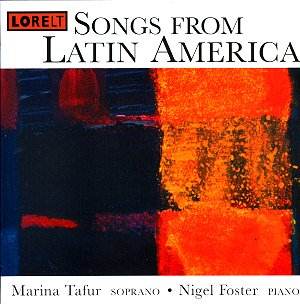Marina Tafur comes from Colombia but having completed
her studies at Bogotá Conservatoire she took further courses
in Paris (with Pierre Bernac), Geneva and New York and has been resident
in the UK for a number of years. She has directed the Abbotsbury Music
Festival in Dorset since 1989. We hear immediately in the first Villa-Lobos
piece that she has an interesting style of vocal production, basically
without vibrato at all, but occasionally allowing long notes to vibrate.
This creates a folkloristic, "uncultivated" sound, and in
the lower-middle register a very beautiful sound. Up on Gs and A flats
(not all that high for a real soprano) the sound also assumes the rather
pinched quality of the "untrained" voice. I began by accepting
this as basically suitable for the folksy nature of the music though
a professional singer to whom I played a couple of tracks was less kind.
Initially I defended Tafur, at least with reference to the repertoire
she was singing (it wouldn’t be a very suitable sound for Brahms, for
example), but as the disc went on I had to admit that my singer-friend
had a point and these high notes began to bother me more and more. Where
a song tends towards the lower range she can be very attractive indeed
– Lecuona’s Quiero ser hombre shows both singer and music at
their best – and the first of the Sas songs shows she can carry this
attractively reedy sound down to a low B. So might some of these pieces
not have been more effective in a lower key (for example, Suray Surita
with its high A flats)? I also think she might have sought a little
more variety of expression, though she manages suitably cat-like sounds
for Villa-Lobos’s "Little Grey Cat". (By the way, this is
listed as an original composition but two Italian listeners independently
identified it as a song they had learnt at elementary school, so is
it perhaps an arrangement of a traditional melody which has migrated
around the Latin world?).
However, I do not want to make too much of these criticisms
since by and large Tafur offers a reasonable guide to some little known
repertoire, almost all of it worth hearing. The Villa-Lobos pieces are
worthy of his reputation as the one Latin American composer to have
"broken" into the Western consciousness, with Ginastera not
far behind. Singers who enjoy the 7 Popular Spanish Songs of Manuel
de Falla should enjoy the Ginastera 5 Popular Argentinian Songs almost
equally. Guastavino and Lecuona tend toward "light" music
but are none the worse for it. Andres Sas divided his career between
Peru and Belgium. His 6 Indian Poems from Peru dress up the folk origins
in a romantic-impressionist style, while Modesta Bor would seem to be
another of the quite large group of women composers worthy of further
investigation. Only the brief examples of Estrada and Valencia failed
to interest me. If we are to understand why Copland thought so highly
of the former as to encourage him to study in the USA we shall need
to hear something of his on a larger scale.
So on the whole a warm welcome for the repertoire,
and on balance my reactions to the singer are more positive than not.
Alternative performances for comparison are hard to come by, as are
scores, but by an odd chance this disc arrived at about the same time
as I was asked to accompany a bass in a programme of Latin-American
composers, including three of the pieces here. This small hands-on experience
seemed to confirm the reliability of these performances. We get translations
and brief notes, not always carefully researched, though a trip round
Internet for missing dates revealed that the dates of some of these
composers seem to be a matter of opinion. I hope the above are correct.
Christopher Howell


